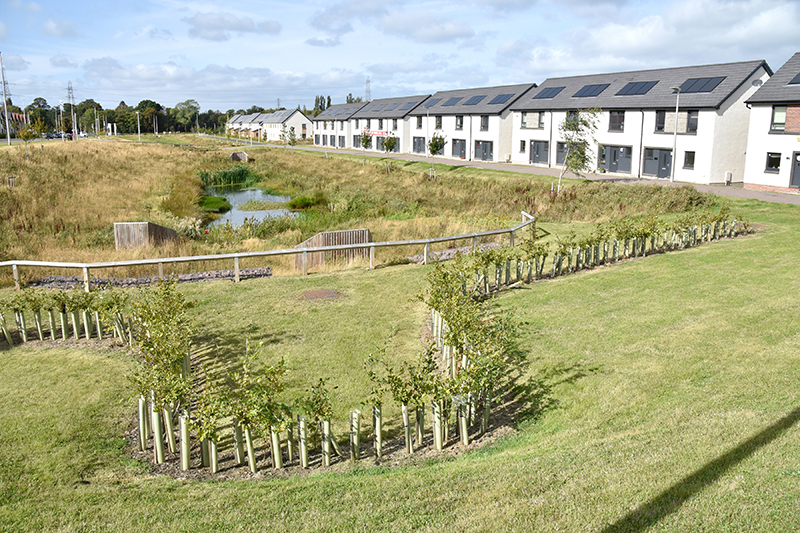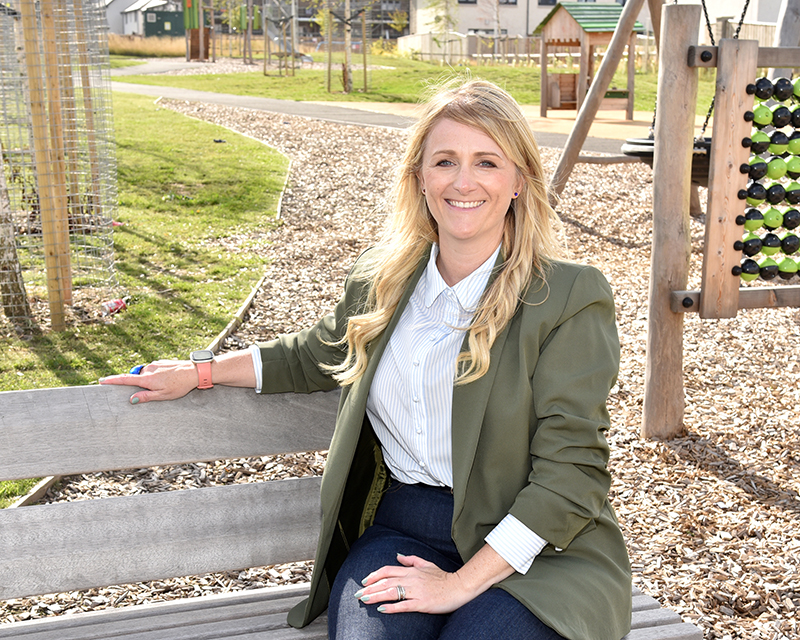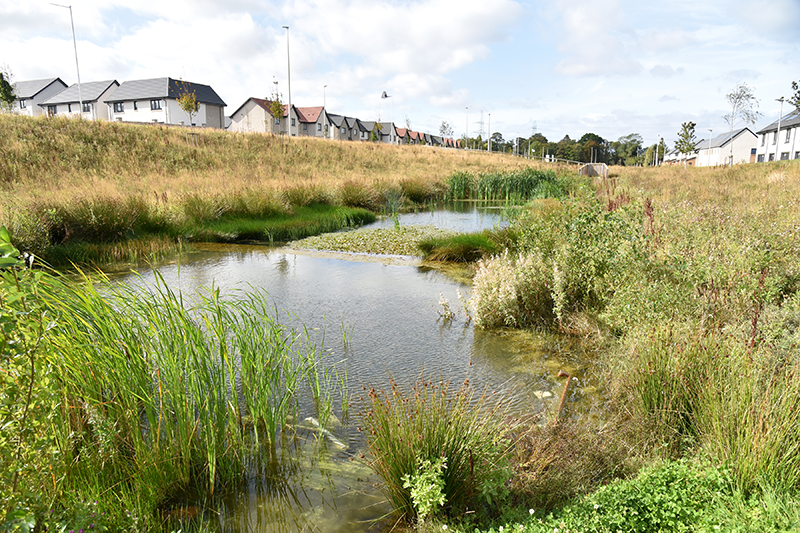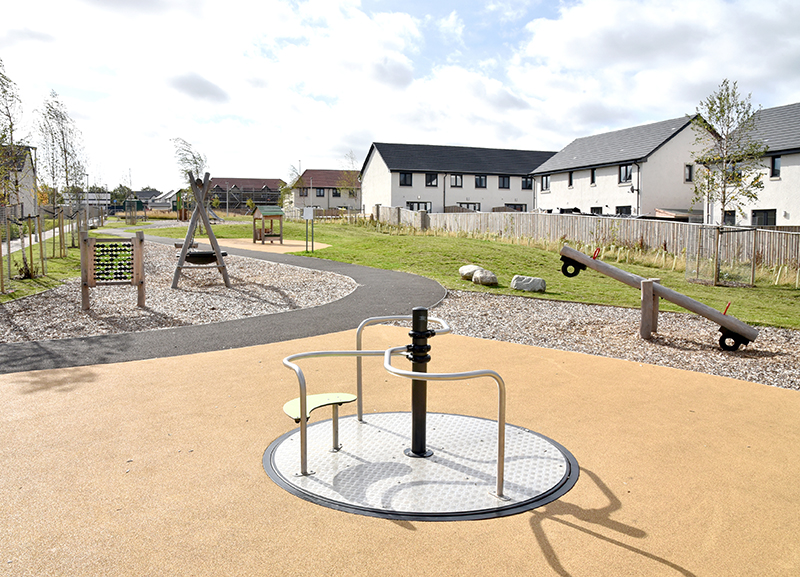
A leading landscape architect has told Project Scotland that the work carried out by professionals in this field is gaining increasing traction amongst developers and housebuilders.
Landscape architects create outdoor spaces that are visually striking, practical, sustainable, and which promote social interaction and improved health and wellbeing. From green roofs and rain gardens to urban streetscapes and water features, a well-designed and high-quality landscape can have a positive impact on the environment and people, as well as deliver significant commercial benefits, including higher yields.
With businesses under increasing pressure to meet ambitious environmental targets and boost their ESG credentials, the role of landscape architecture – once an ‘afterthought’ in the development process – has taken on paramount importance.
Emma McNicholas is a director at OOBE, a landscape architecture practice with studios in Newcastle, Glasgow, Edinburgh, and Birmingham. The firm offers services including landscape architecture, urban design, masterplanning, and BIM. OOBE has delivered projects across a range of sectors such as housebuilding, commercial, education, leisure, and public realm.

Emma spoke to Project Scotland at Blindwells, a new community in East Lothian which will eventually comprise some 1,600 homes alongside education and healthcare facilities, a town centre, and a retail element.
Developer Hargreaves is transforming the brownfield site over many years. OOBE has been involved in the landmark project since 2020 when it was brought in to help with the first phase in delivering soft landscaping. Since then, the team has worked alongside EMA Architects, CBRE, and Waterman Group on features ranging from a loch and multiple playparks through to town centre design, tree planting, and even artwork scattered throughout the site. OOBE has also been liaising with the Battle Trust to learn about the Battle of Prestonpans, which took place in the vicinity, with a view to incorporating tapestry within the grounds to commemorate the battle.
Emma revealed that OOBE has come a long way since being launched in 2010 by founding directors Mike Goodall and Oliver Smith. The head office has always been in Newcastle, but OOBE has had a presence in Scotland for around six years, the catalyst of which was its involvement in Moda’s Holland Park residential-led development in Glasgow city centre.
A second Scottish hub followed in Edinburgh. “Originally it was all about design and being underpinned by technical rigour,” Emma revealed. “The business has evolved over the years. We’re fully BIM integrated now. We do everything in Revit.

“We took the decision in 2020 to move more towards a sustainability goal. We want to design landscapes that are not just beautiful in terms of design but are sustainable. It was really about evolving with what the market needed and what we as landscape architects are wanting to achieve.”
At the time of interview, OOBE was in the process of increasing staff headcount to 25. A five-year growth plan is in place, which involves doubling that number and adding more disciplines including visual impact assessments and potentially ecology.
For Emma, landscape architecture is about bringing everything together.
“It’s the glue that binds,” she explained. “From built environment, ecology, arboriculture, planning – we’re basically the bit that creates the place as well as the buildings. I think in terms of importance, it’s high on the agenda. Landscape in the past has been second to architecture. Following Covid and people being stuck inside, outdoor space is (now considered) so valuable. And communal outdoor space is really valuable too.

“We’re seeing a lot more developers who are looking at their ESG targets, really wanting to make more of that outdoor space, and actually what they’re finding is that if they’ve got good quality outdoor space, their properties, developments, or office buildings can be rented out or sold for more.”
OOBE prides itself on helping developers to meet planning aspirations and get the very best out of landscapes. Emma explained that early involvement in projects is vital and can make the process of securing the likes of Fitwel or BREEAM certification much smoother.
She describes the benefits of a good landscape as ‘massive’, citing Scotland’s National Planning Framework (NPF) 4, which focuses heavily on health and wellbeing as well as the social aspect of ESG.
“You could create a beautiful landscape but if nobody uses it, what are the health and wellbeing benefits? There’s lots of studies and facts out there about the potential benefits not only on health, but preventing people from getting ill as well, and also from a social side – mental health, biophilic design, that connection to nature,” Emma added.

“We’re all about trying to get that balance right between creating landscapes that are environmentally sensitive but also about bringing people together and have social impact as well and health benefits.”
Similar to other disciplines across the construction and built environment sectors, Emma revealed there is a major skills shortage within landscape architecture. Despite the wealth of opportunities available, it can be a struggle to attract fresh talent into the profession, with Emma keen to highlight the variety of work on offer.
“I like being outdoors, but I liked design as well so for me it was a great balance between the two,” she said. “My family are all project managers, so I’ve been brought up with ‘plan, plan, plan’. A big part of landscape architecture is about planning and project management. There are so many different facets to landscape architecture because you’re bringing all these different disciplines together.
“I have a thing about trees, and the benefits trees bring in terms of carbon capture and air quality. And then there’s the planning side of it. There’s the design, the technical side, the construction. There are so many different things; it’s a really exciting profession to get into.”
At Blindwells, Emma revealed one of the biggest challenges has been the location and its close proximity to the Firth of Forth.
“It’s so open and exposed. Because it was a brownfield site as well, the remediation has been quite extensive. We’ve got challenges with soil quality. We’re having to do lots of additional remediation to soils to be able to grow anything in it.”
Blindwells is one of a number of challenging and high-profile projects OOBE has been involved in north of the border.
As well as the work with Moda Living in Glasgow, OOBE was also engaged on a Build to Rent (BTR) project with the brand at The McEwan in Fountainbridge, Edinburgh. The initiative involved 450 units built over two phases, featuring three large blocks and a significant public realm.
OOBE was also commissioned to provide an inspiring learning environment at Renton Campus in West Dunbartonshire. The firm helped transform the outdoor learning and play space at the school with facilities including a plaza, multi-use game area, and rooftop playground. Emma admits she was brought to tears during the open day when she saw the impact on the community.
Looking ahead, Emma expects the importance of sustainability to ramp up over the decade, with ever more stringent rules in terms of what can and cannot be done.
“As a landscape architect we’re at the forefront of shaping that, influencing it, and getting the best out of the landscape to meet our clients and end users’ expectations,” Emma said.
“As a business we’re seeing more enquiries from clients coming through asking if we can get involved at an earlier stage, not just in rural settings or new developments of this scale, but also in the city centres as well and really making those connections and providing external greenspaces for everybody.”











